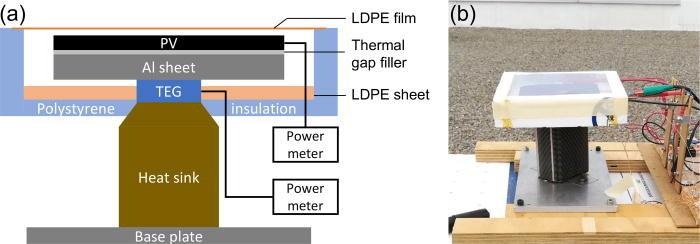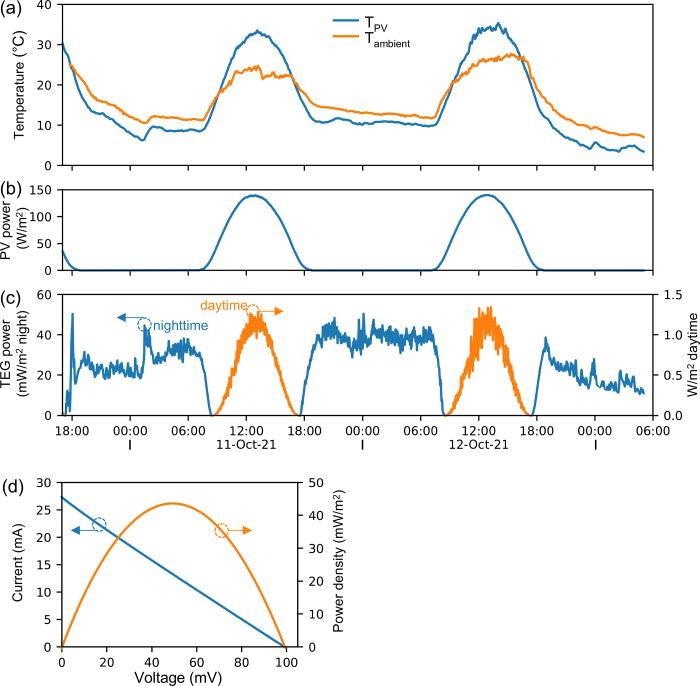
While there have been diverse conceptual suggestions and practical implementations of energy harvesting from a PV cell’s radiative cooling at night, the power density obtained is quite low.
Researchers have built a thermoelectric generator that generates electricity from the difference in temperature between the PV cell and the surrounding environment. This research has been published in Applied Physics Letters.
With a clear night sky and a 100 mV open-circuit voltage, researchers obtain 50 mW/m2 nighttime power generation, which is orders of magnitude greater than earlier performances.
Producing power during the night in many rural regions relying on mini-grid or off-grid systems sometimes demands major additional battery storage installation, which adds significant system complications.
Heat transfer from a hot source to a cool sink is required to generate work from heat, according to thermodynamics. During the day, a PV cell acts as a heat engine, converting solar energy shining on the PV cell into electrical power utilizing the Sun as the heat source and the Earth’s ambient surrounds as the cold sink. Radiative heat flux from Earth to outer space occurs in addition to solar irradiation.
Since the Earth’s atmosphere is clear in the mid-infrared wavelength range, such outward heat transfer is conceivable. As it must, on average, balance the heat flow from the incoming solar flux for Earth to sustain its temperature, the magnitude of such departing heat flow is very significant.
As a result, every item on Earth that has access to the sky can radiate heat into space, providing a method for radiative cooling. The recent focus on accomplishing cooling in diverse materials and incorporation in energy-related activities, such as building cooling, has sparked a lot of interest in this type of radiative cooling effect.
The PV-TEG device’s operating principle is depicted in Figure 1 from the standpoint of the PV cell’s energy balance at night.

The PV-TEG device’s design drawing and completed prototype are shown in Figures 2(a) and 2(b). The device is built around a SunPower C-60 monocrystalline silicon solar cell with an A = 153 cm2 surface area.
Researchers designed an air-insulated chamber around the PV cell with an entrance at the bottom for heat sink connection to limit parasitic heat flow with the ambient. Low-density polyethylene (LDPE) film is used to cover the top of the chamber, which is translucent for both visual and mid-infrared wavelength ranges.


The power and temperature readings are shown in Figure 3. Temperature measurements (Figure 3(a)) reveal that the PV cell warms up during the day because of absorbing solar radiation. The PV cell reaches a peak temperature difference of roughly 15 °C above ambient around midday. Figure 3(b) shows how the measured daytime temperature difference correlates with PV cell power.
The TEG power values are shown in Figure 3(c).
For the nights of October 10 and 11, when the sky is clear, Figure 4 indicates that the recorded nighttime power generation coincides well with the prediction models.

Conclusion
In conclusion, researchers have developed a PV-TEG system that can prolong PV cell power generation into the night by employing radiative cooling while also supplying extra power during the day. Based on region and sky quality, nocturnal power generation ranges from 10 to 100 mW/m2.
In off-grid and mini-grid situations, where PV cell installations are becoming more prevalent, the solution can supply midnight backup lighting and electricity. Since thermoelectric generators have a long service life, the proposed system may have lower long-term maintenance costs than battery storage.
The documented power density is already attracting attention for applications such as nighttime lighting. The system can also power sensors in far-flung places, lowering or eliminating the need for battery storage.